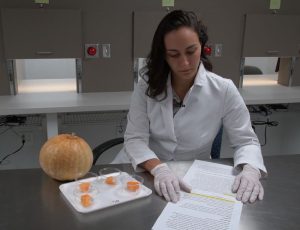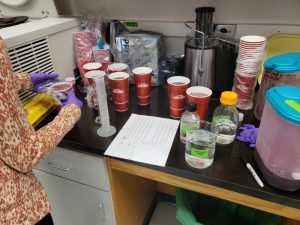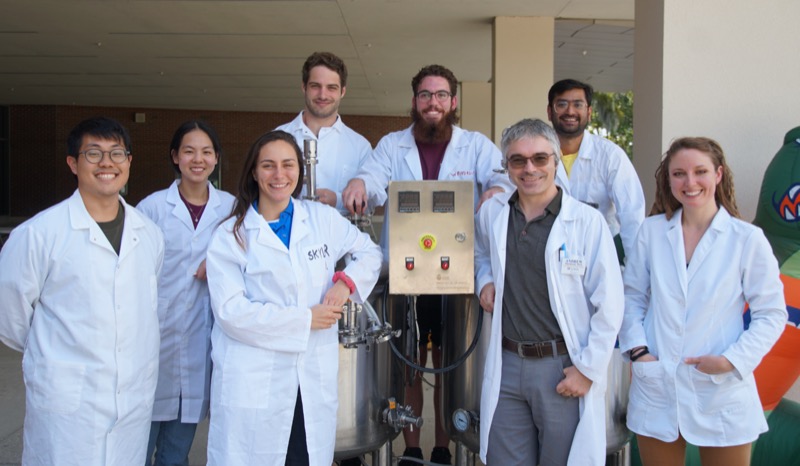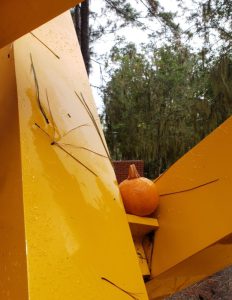 Hello, and welcome back to FSHN Research Journeys, which follows the research of graduate students in the Food Science and Human Nutrition program at The University of Florida. Today’s guest poster is Skylar Moreno, a first-year master’s degree student in food science. Her project is designed to expand the Florida pumpkin market and builds on the work of her graduate mentors, Dr. Andrew MacIntosh and Dr. Charles Sims. Below, learn about the growing need for tropical pumpkins and the methods used to create and characterize hardier cultivars.
Hello, and welcome back to FSHN Research Journeys, which follows the research of graduate students in the Food Science and Human Nutrition program at The University of Florida. Today’s guest poster is Skylar Moreno, a first-year master’s degree student in food science. Her project is designed to expand the Florida pumpkin market and builds on the work of her graduate mentors, Dr. Andrew MacIntosh and Dr. Charles Sims. Below, learn about the growing need for tropical pumpkins and the methods used to create and characterize hardier cultivars.
Skylar: A popular fruit often used to mark the fall season will be finding its way into stores with a Florida Grown sticker. Often used to make pies, decorate your home, or ward off evil spirits, the pumpkin is a cooking staple for many countries.1 The pumpkin as we know it is a crop commonly grown in the northeastern part of the U.S. and is usually bred for carving. Yet there are many pumpkin varieties to choose from. The tropical pumpkin, Calabaza, is an emerging crop in the U.S., and it’s looking for a new place to grow.
The Produce Florida Farmers Didn’t Know They Needed

There are 13 different species of pumpkin but only four make up the current US market.2 Of these four species, two predominant species of pumpkin can grow in Florida–Curcurbita pepo and Curcurbita moschata–due to their resilience in hot, humid climates.3 With expanding market demand for pumpkins, can Florida be one of the new major pumpkin providers?
Enter the Calabaza. The tropical pumpkin or Calabaza (Cucurbita moschata) is native to Central America. Yet it has never become a commonplace produce item within the US. Demand for tropical pumpkins is likely to increase due to growing populations of ethnic communities, such as from Central America and South America, within the US.4 The total value of tropical pumpkin consumed in the U.S exceeds $30 million annually, but >80% of the produce consumed is imported from Central America.5 Current Florida production is limited to a few hundred hectares in subtropical Florida due to its ideal climate for the crop.
Expanding Production of Florida Pumpkins
The current pumpkin varieties available lack the yield, climate adaptability, quality, and growth rate required to fuel the growing demand. Therefore, the UF Horticultural Sciences Department is creating pumpkin cultivars that can grow in a wider range within Florida to further support the local economy. Food scientists, like myself, can characterize the pumpkins to ensure these cultivars are not compromised in flavor and important nutritional characteristics that comprise the Calabaza.

According to the Information Resources, Inc.’s innovation report, as of the end of 2020, products with origin claims (e.g., ”made in the USA” and ”local”) posted the highest dollar sales growth among foods and beverages carrying a benefit descriptor.6 The opportunities to promote smaller Florida-run businesses and farmers selling Florida fresh produce could reduce the overall environmental impact of farming. Further, these promotions may foster a community-based initiative that consumers will appreciate and pay for.
Additionally, through novel food applications using the Calabaza, we believe there will be further demand within the US. As of 2021, Datassential notes that three-quarters of adults in the US seek new food and beverage ideas.7 This specialty crop can therefore be the source of novelty for future product applications.
Through this development of Florida-grown specialty pumpkin cultivars, I will be characterizing the UF horticulture grown Calabaza cultivars through sensory taste panels as well as physical and chemical analyses. However, my research into characterizing tropical pumpkins is not my first journey into the sensory characteristics of raw produce.

Skylar’s Love for the Outdoors Leads to Research in Sensory Applications
My admiration for nature has fueled my passion for immersing myself in the farm fields. This passion began in high school when I helped initiate a gardening club at a local tree grove. This club became a weekly educational gathering that highlighted gardening applications such as testing soil pH levels, composting, and grafting plants. Witnessing this connection between what we grew and the food I consumed further inspired my desire to contribute to our food industry.
While working in the Blueberry Breeding Program at UF, I conducted sensory tests on blueberry cultivars. Through this program, I witnessed the faculty’s approachable and empathetic nature towards its students. This comforting display confirmed the University of Florida as my first choice school to pursue higher education and solidified my career purpose.
From these experiences,, I have gleaned that the most impactful way to contribute to the food industry is to combine food science and plant genetics to optimize the flavor, shelf life, disease resistance, and applications of fresh produce. This overlap will balance the push for longer-lasting produce and the need to retain nutritional value and flavor in the raw foods we eat. By earning my master’s degree, I can pursue my desire to impact the agricultural industry.

Characterizing Calabaza Cultivars

My goal is to determine consumer acceptability of Calabaza cultivars under the guidance of Dr. Andrew MacIntosh and Dr. Charles Sims. With this information and knowledge of cultivar characteristics, we can find processing applications that best showcase Calabaza within the US market. One application I will research is the consumer acceptability of raw and frozen microwaved Calabaza. The process of freezing has been shown to not only extend shelf life but also have minimal loss of quality and nutrition over time.8
Microwaving is rising in popularity as a cooking method with its short cook time, safe handling, and low maintenance.9 With these convenience processing preparation preferences in mind, raw and frozen Calabaza pumpkins will be cooked in a microwave and served to taste panelists to determine consumer opinions of microwaved produce. Complementary lab analysis will compare treatments. As a result of my work, I plan to unveil an ideal pumpkin for consumers.
By performing these analyses, we will encourage farmers with consumer data to grow this new and upcoming specialty crop. So, the next time you search for a pumpkin within your stores, look for the Florida Grown sticker. Your contribution will go a long way towards the development of our local economy and could encourage others to try something new.
Skylar Moreno was born in Miami and grew up in Key West, Florida. She majored in food science at the University of Massachusetts Amherst before transferring and finishing the rest of her bachelor’s degree in food science at the University of Florida. She is currently pursuing her master’s degree in food science under the mentorship of Dr. MacIntosh and Dr. Sims in Gainesville, Florida. She is an avid gardener and enjoys sharing her plant collection with anyone.
References
- Szydlowski, M. (2014). The Science of Pumpkins. Columbia Daily Tribune. Retrieved October 24, 2021, from https://www.columbiatribune.com/article/20141029/Lifestyle/310299904.
- (2021). Pumpkins. Agricultural Marketing Resource Center. Retrieved February 7, 2022, from https://www.agmrc.org/commodities-products/vegetables/pumpkins
- Mallinger, R.E., Liburd, O.E. (2021). Pollination of Cucurbita spp. (Squash and Pumpkin) Crops in Florida (ENY-2056). Gainesville: University of Florida Food and Agricultural Sciences. Retrieved February 7, 2021, from https://edis.ifas.ufl.edu/pdf/IN/IN131100.pdf
- Flores, A., M.H. Lopez, and J.M. Krogstad. 2018. The U.S. Hispanic population reached a new high in 2018, but growth has slowed. Pew Research Center. https://www.pewresearch.org/fact-tank/2019/07/08/u-s- hispanic-population-reached-new-high-in-2018-but-growth-has-slowed/.
- USDA- Economic Research Service. 2011. Pumpkin: U.S imports by value. USDA National Organic Standards Board. 2018. Research Priorities, 2018. https://www.ams.usda.gov/sites/default/files/media/MS2018ResearchPrioritiesOct2018Web.pdf.
- 2021. Innovation for a Post-Pandemic World. Feb. IRI, Chicago. iriworlwide.com
- 2021. “Trending Upward.” Webcast, Feb. 19. Datassential, Los Angeles. datasssential.com
- Paciulli, M., Ganino, T., Carini, E., Pellegrini, N., Pugliese, A., & Chiavaro, E. (2016). Effect of different cooking methods on structure and quality of industrially frozen carrots. Journal of Food Science and Technology, 53(5), 2443–2451. https://doi.org/10.1007/s13197-016-2229-5
- Silva, M. de, Sousa, P. H., Figueiredo, R. W., Gouveia, S. T., & Lima, J. S. (2019). Cooking effects on bioactive compounds and sensory acceptability in pumpkin (cucurbita moschata CV. Leite). REVISTA CIÊNCIA AGRONÔMICA, 50(3). https://doi.org/10.5935/1806-6690.20190047
 0
0
